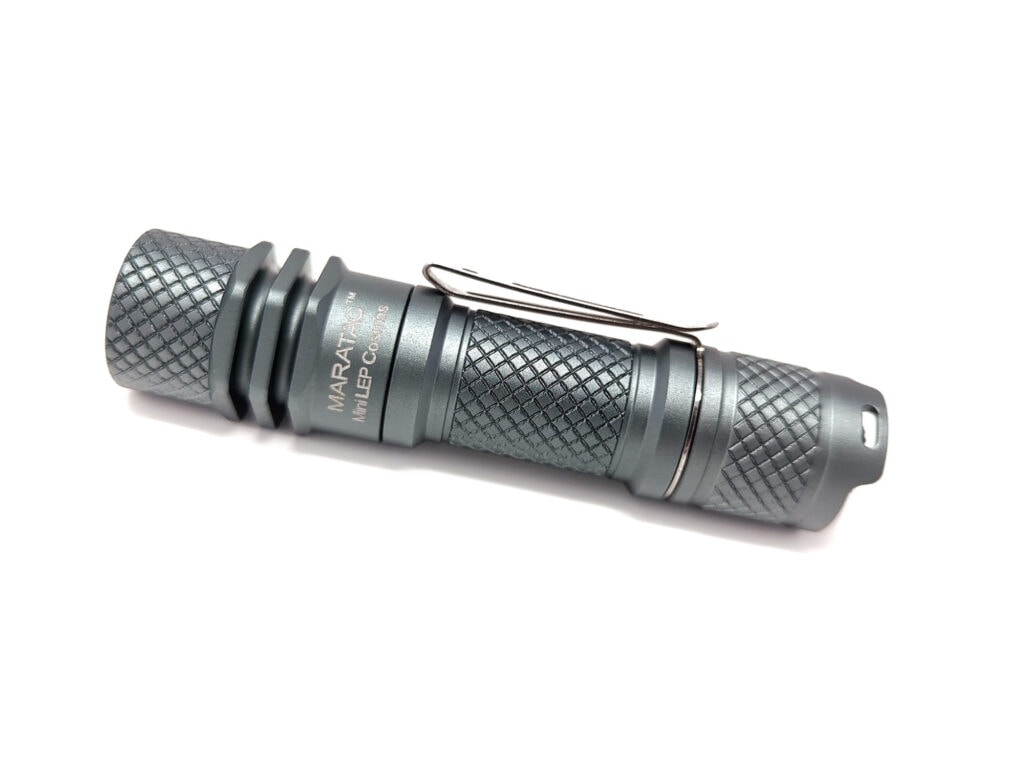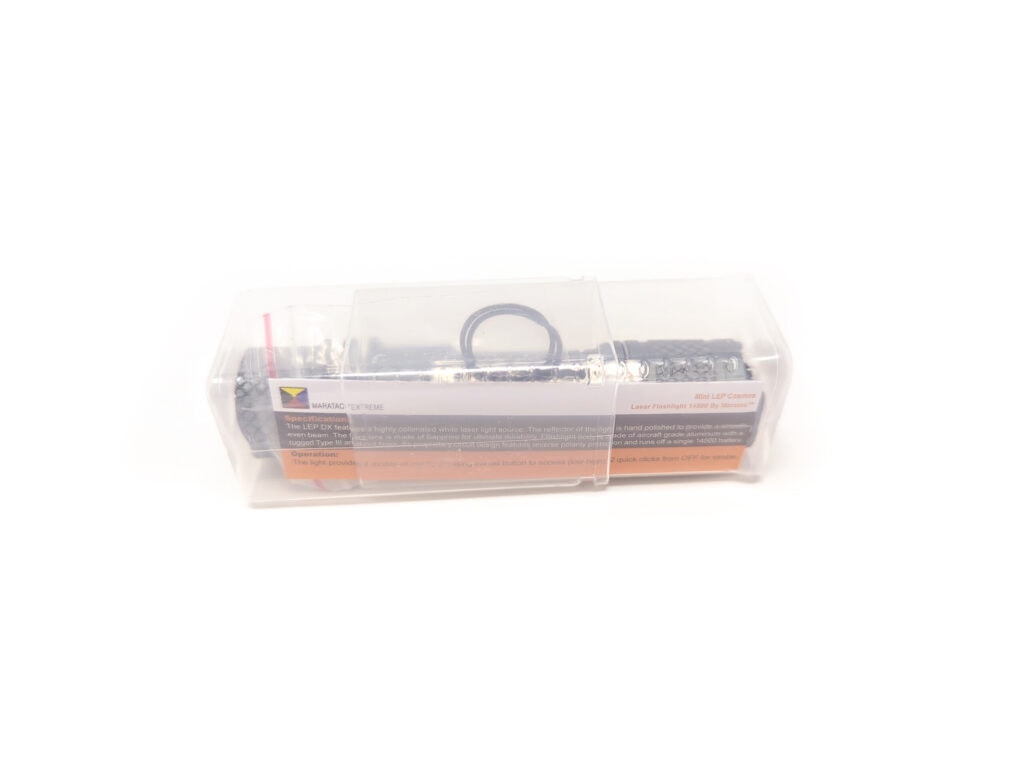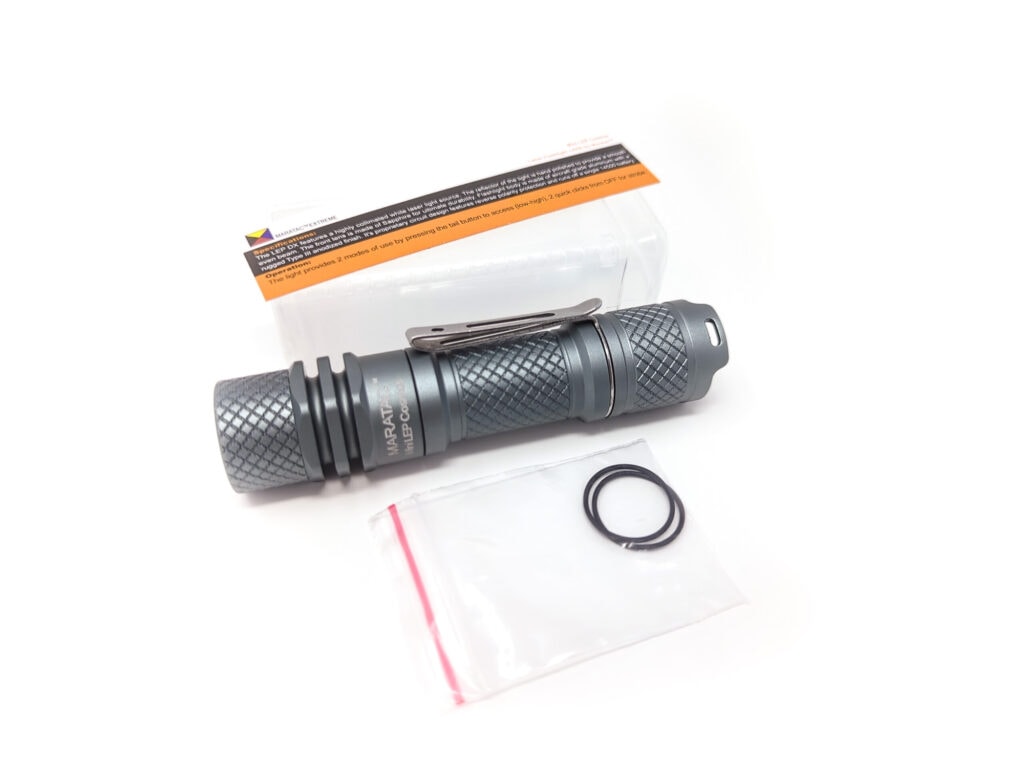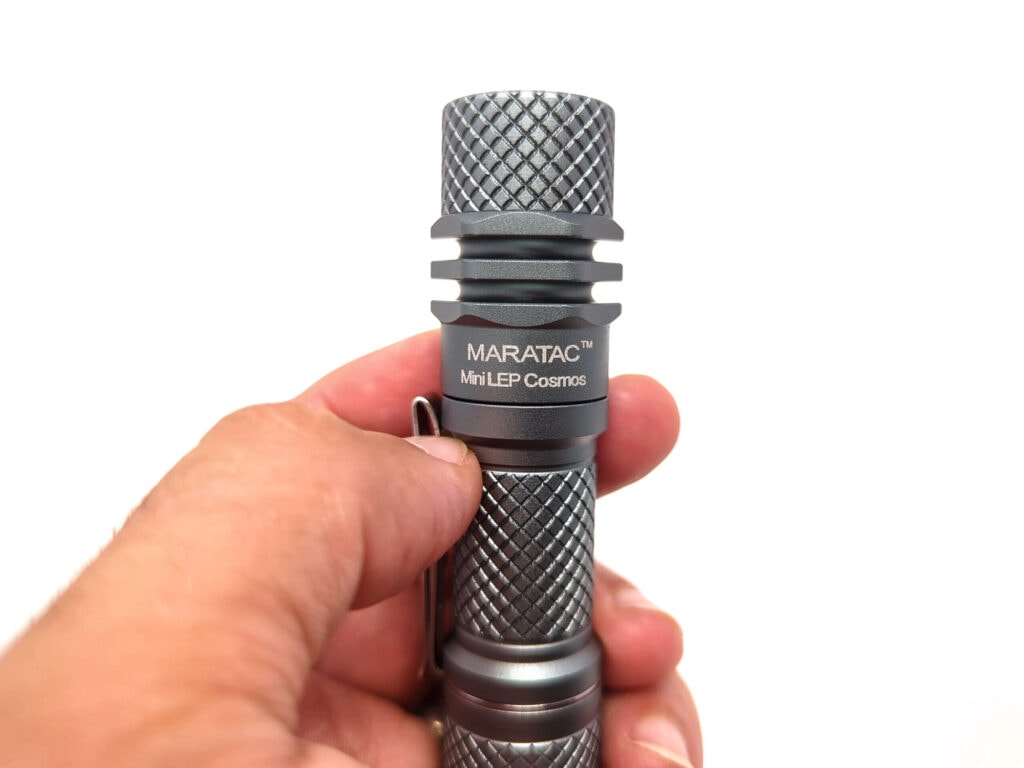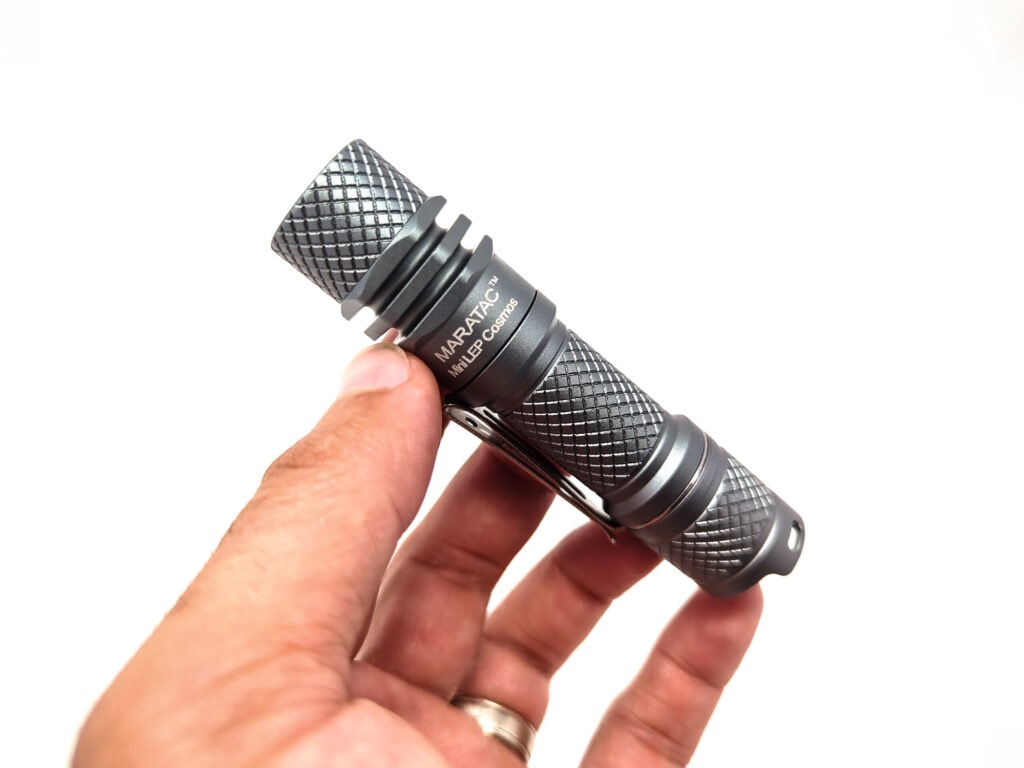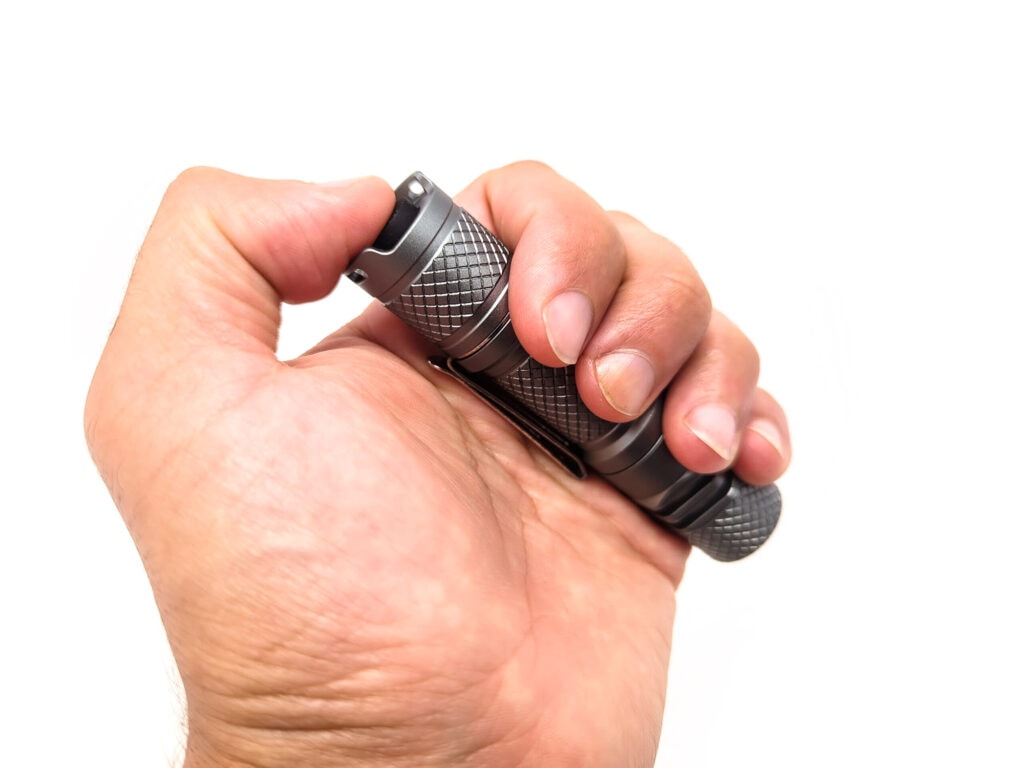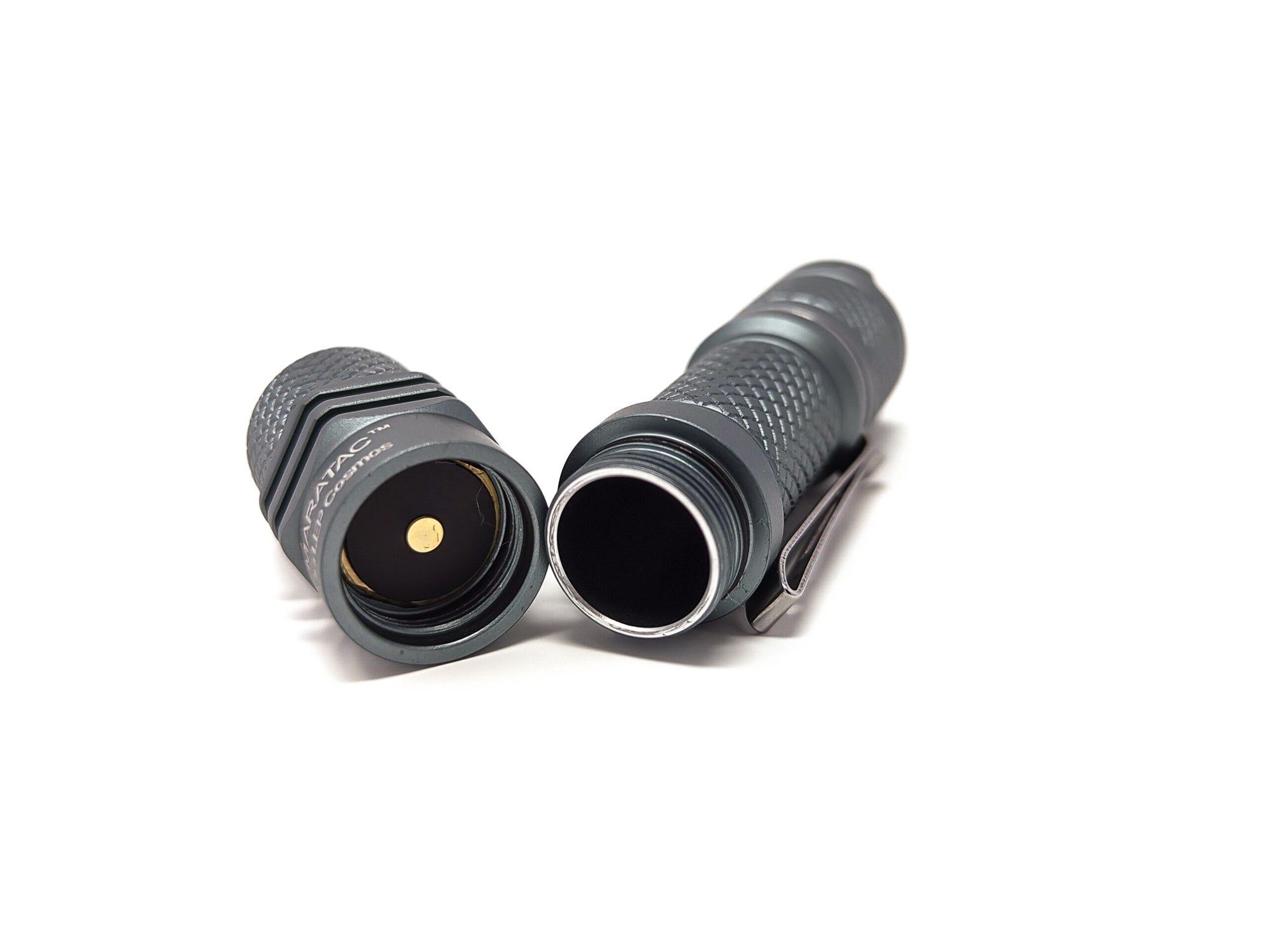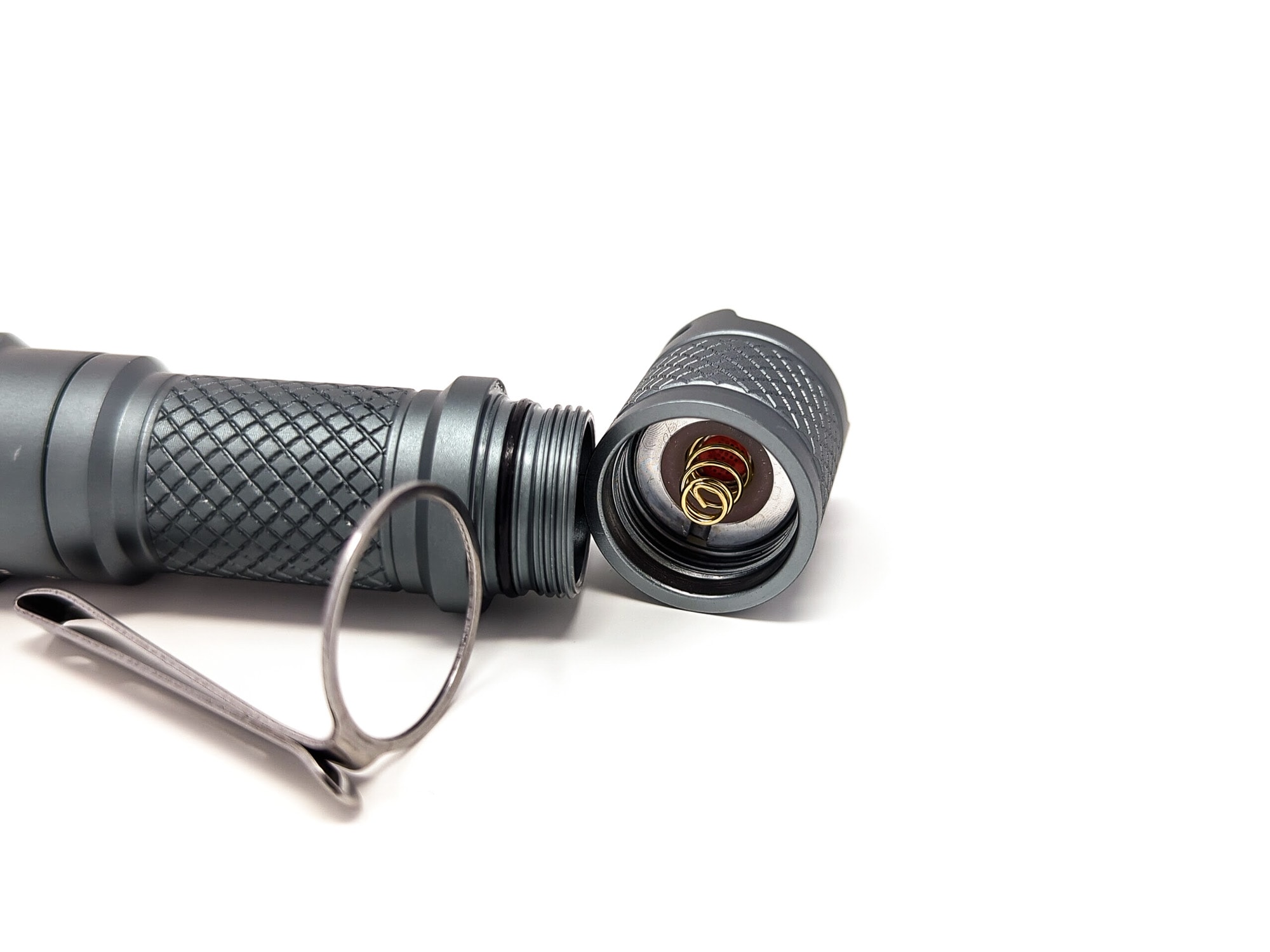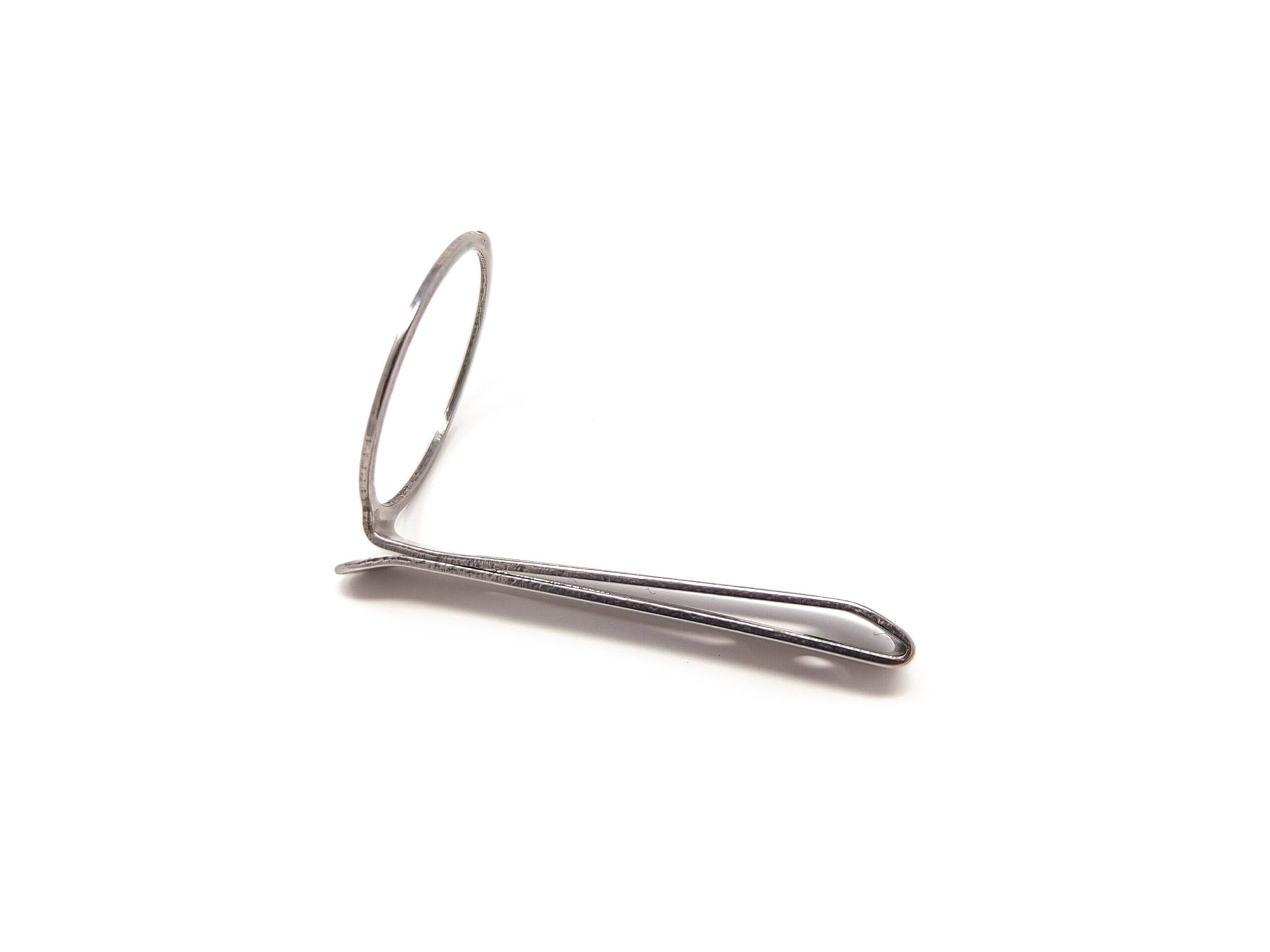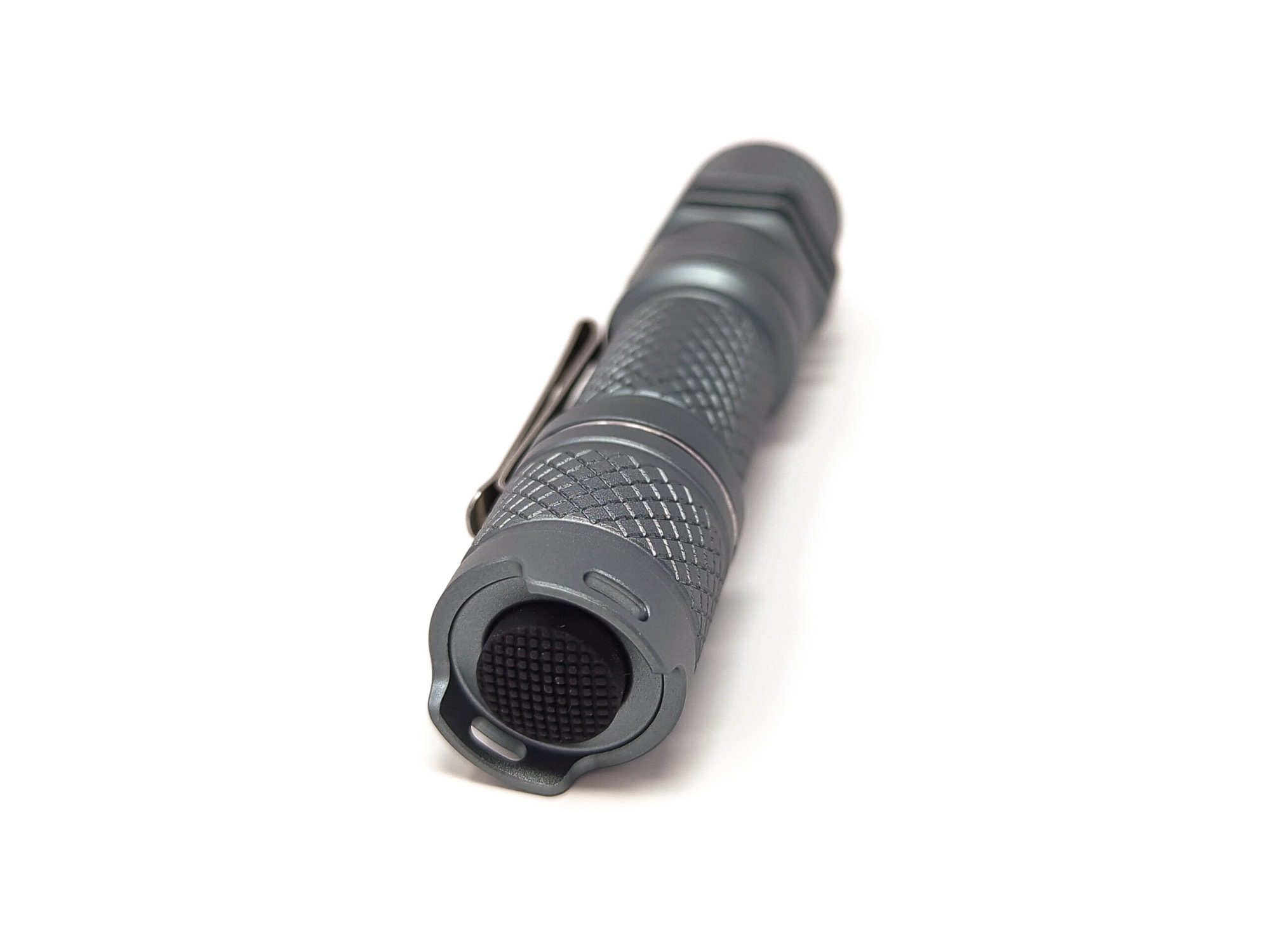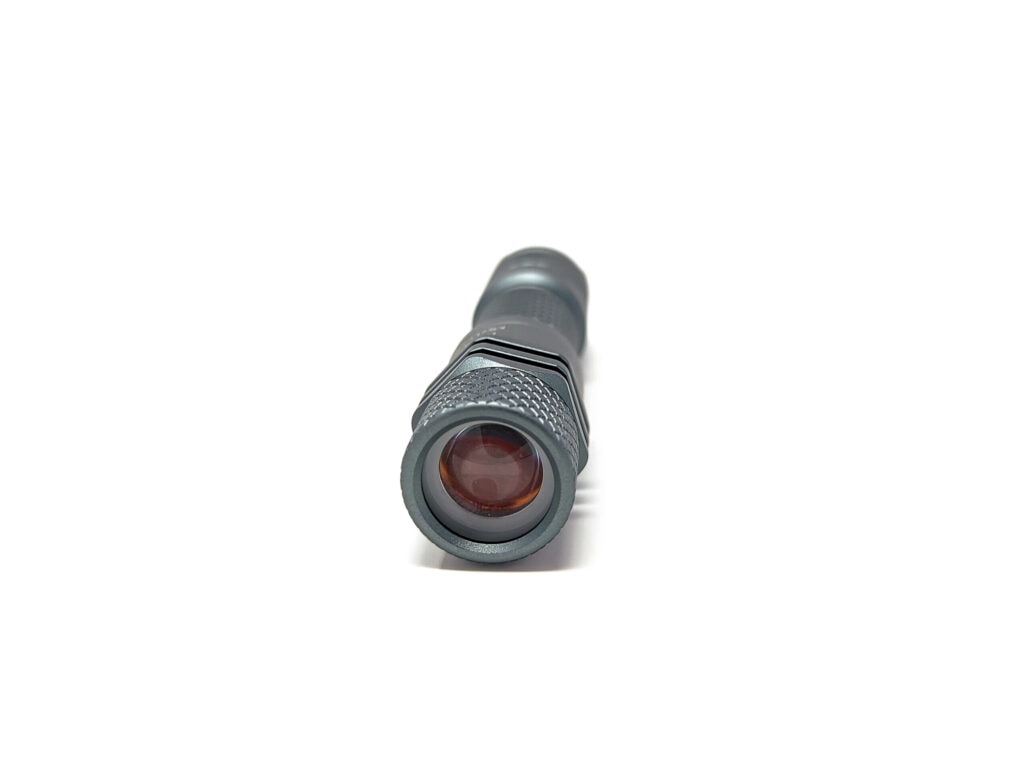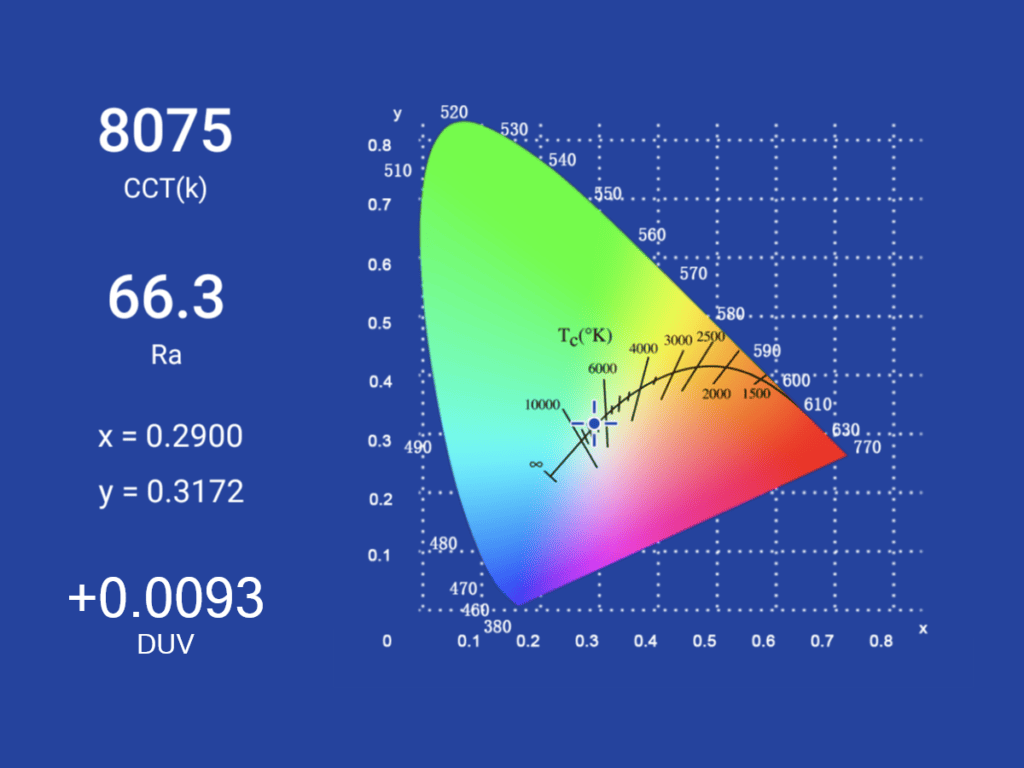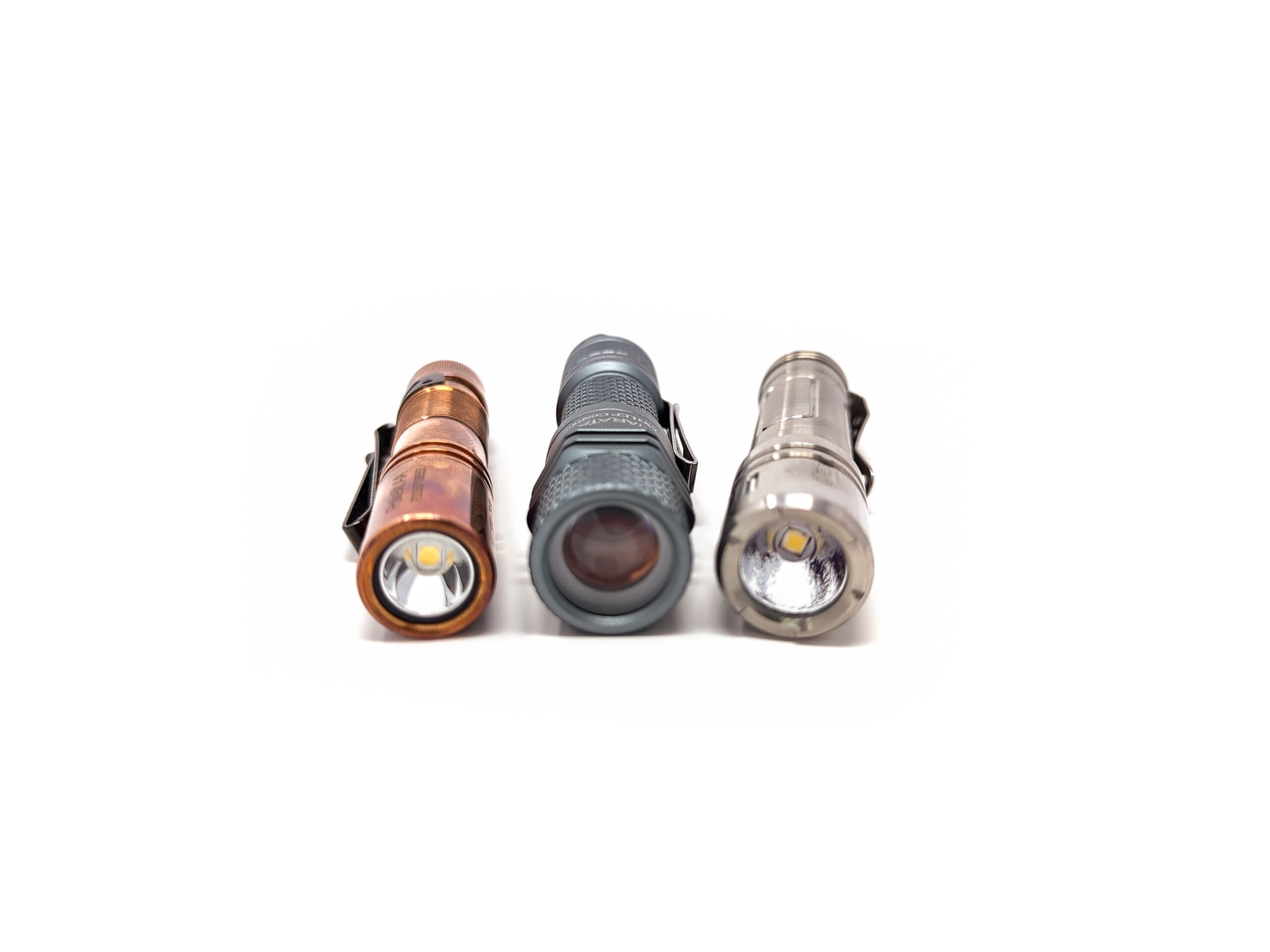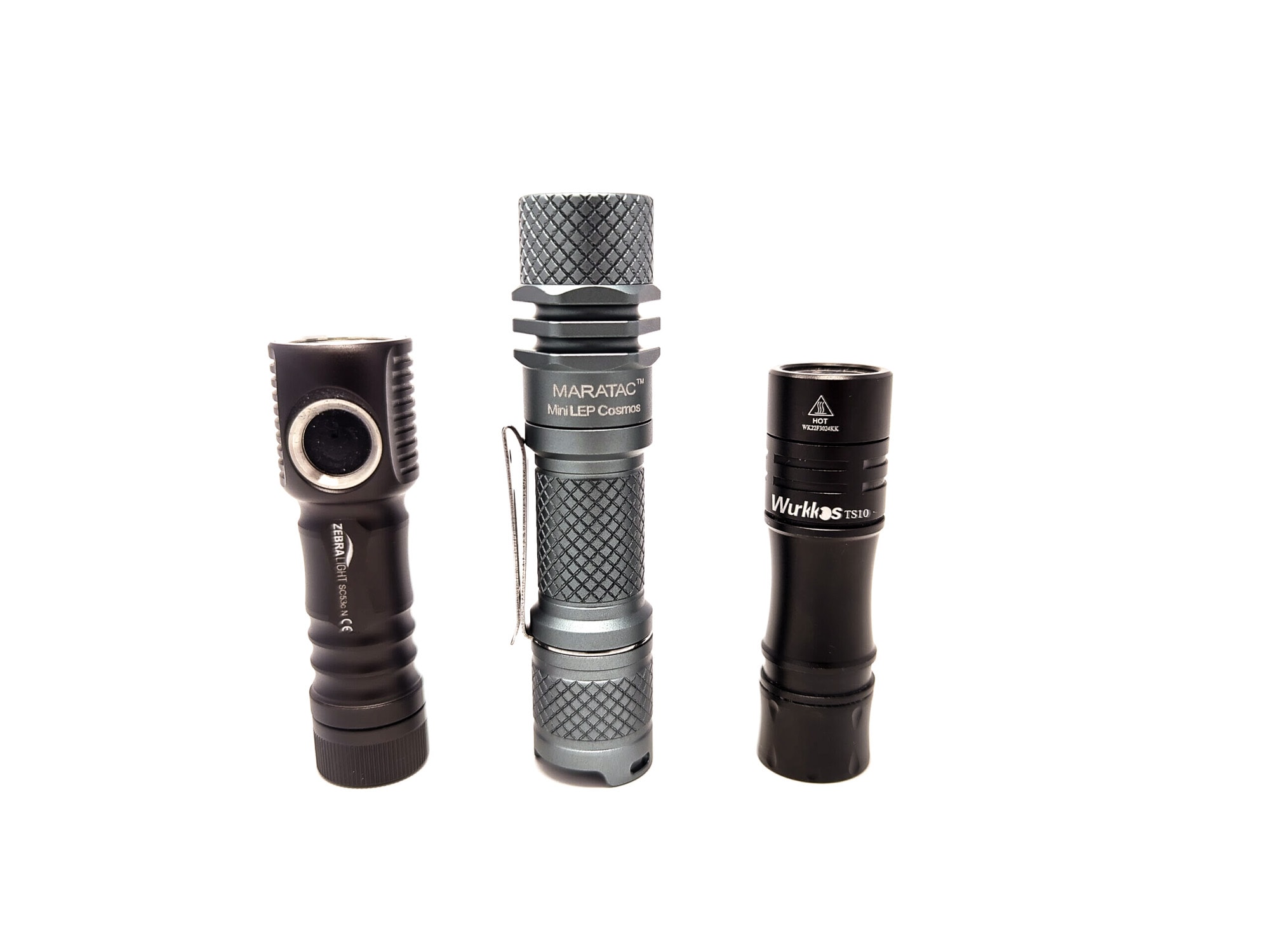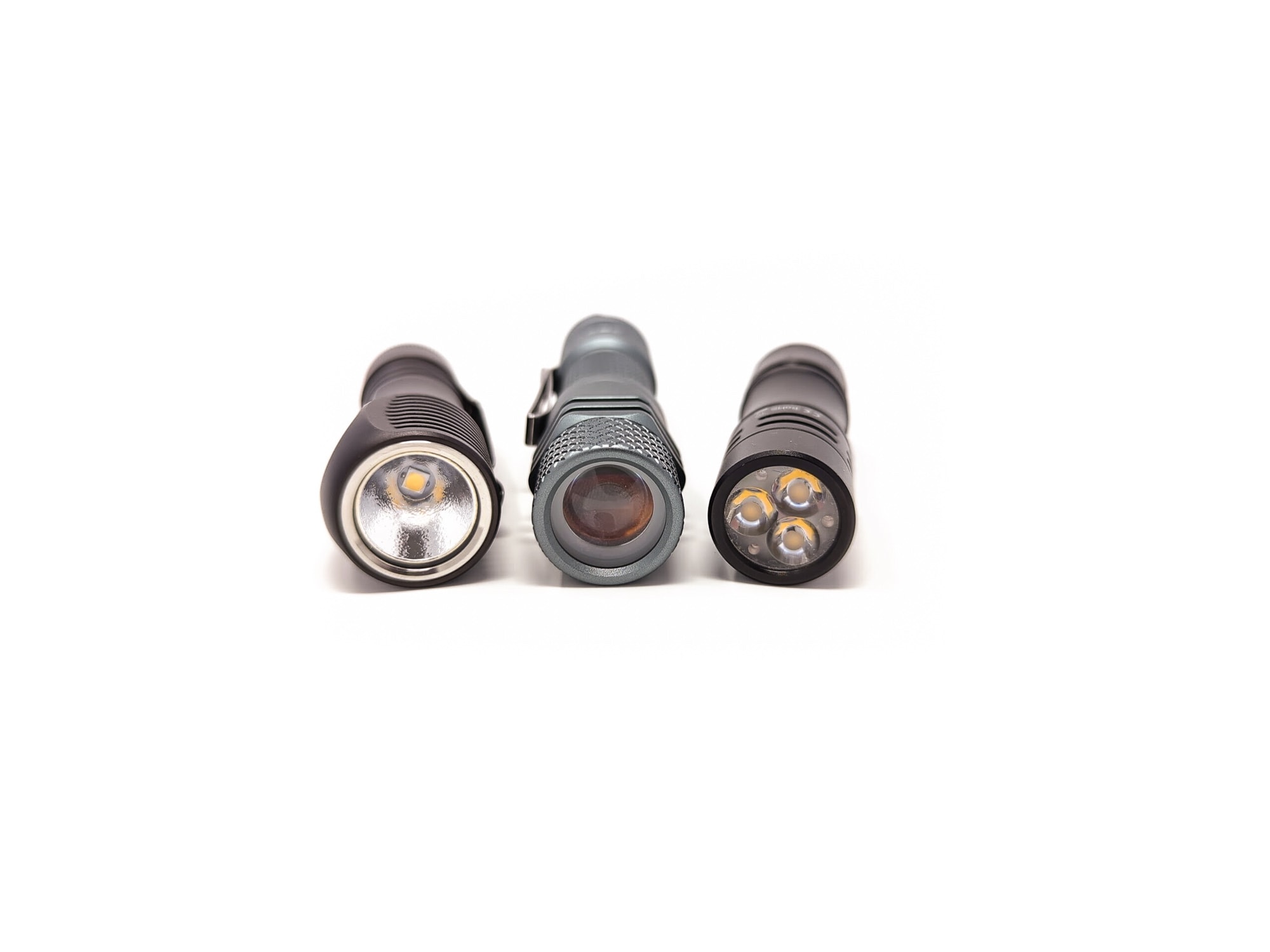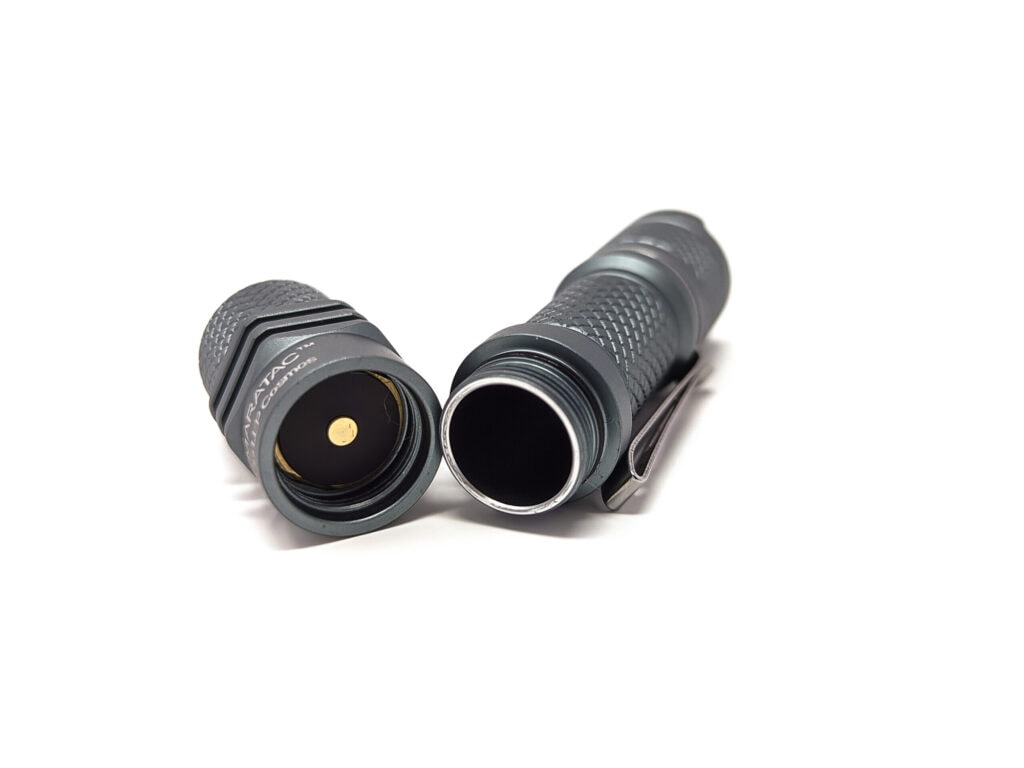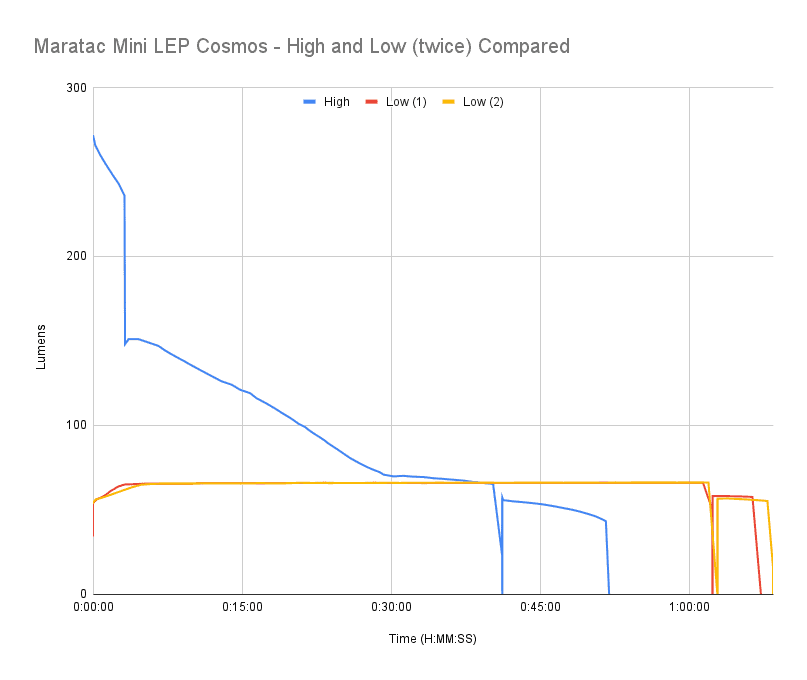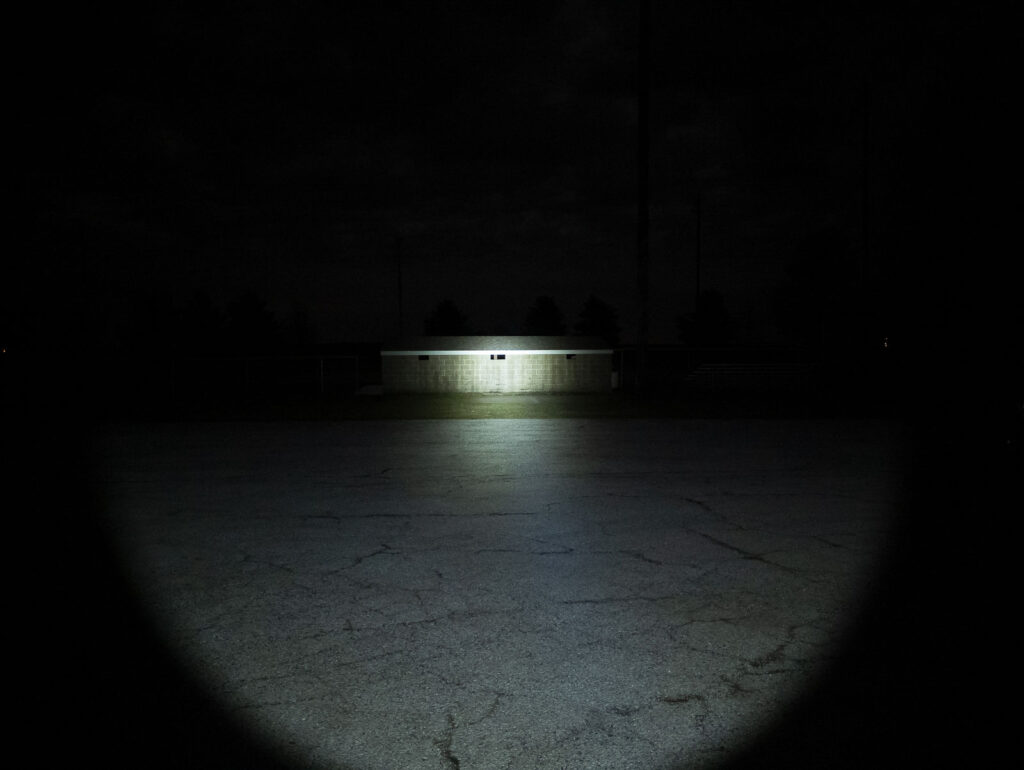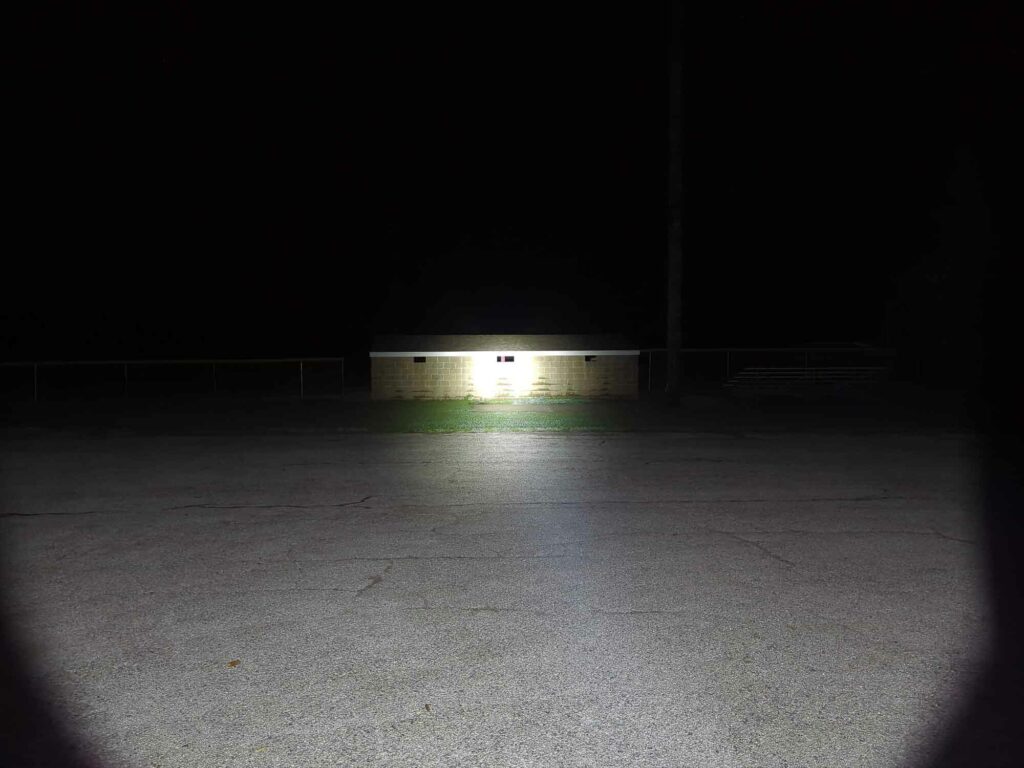1lumen selects and reviews products personally. We may earn affiliate commissions through our links, which help support our testing.
Maratac Mini LEP Cosmos review
Maratac Mini LEP Cosmos specs
| Brand & Model | Maratac Mini LEP Cosmos |
|---|---|
| Flashlight category | Mini thrower, long-range |
| LED | LEP |
| Max. output | 260 lumens |
| Max. beam distance | 792 meters |
| Max. beam intensity | 124,972 cd |
| Battery config. | 1x 14500 flat-top |
| Onboard charging | N/A |
| Main modes | 2 |
| Blinkies | Strobe |
| Waterproof | IPX8 |
| Review publication date | September 2023 |
Review intro:
The Maratac brand of flashlights are produced by/for a company called CountyComm. It’s a pretty neat company with a lot of awesome, high-quality products. In their own words: CountyComm designs, manufactures and sells select products to federal, state and local government agencies. Specializing in EDC ( Every Day Carry ) or in other places, Limited GOV overrun tactical goods brought to the consumer market. So… they make products to meet the exacting demands of US government agencies and then sell extras (or additional batches) directly to consumers. I’ve purchased items from CountyComm before (like their excellent glow tape) and have had the chance to review a couple of their recent Maratac flashlights, the Ti Peanut Beast and Tri Flood Pro.
If you take a look at the Lights section of CountyComm’s website, you might begin to notice that these aren’t 100% original designs. Rather, it seems like CountyComm partners with other known brands (Lumintop, Reylight, Acebeam). The Maratac light may share a similar layout as an existing light, but will have unique aspects like a different UI, materials, or knurling.
CountyComm was kind enough to send their Maratac Mini LEP Cosmos flashlight for testing. Just because this guy is pint-sized doesn’t mean it’s lacking oomph. This is the Mini LEP Cosmos we’re talking about here, which for the uninitiated means it utilizes a laser-excited phosphor. Yes, laser. So even though we’re not talking about a lot of lumens here, this Maratac has a long reach.
To get started with it, you’ll need to pop in a charged-up battery. Note that CountyComm does not provide a 14500 with this unless you order it separately.
Package quality.
When I received my first couple of Maratac flashlights, I was a bit shocked at their packaging. Everything was tightly crammed into a little, clear, plastic square-tube. I wasn’t sure if it was just those models, but this one arrived in the same manner. So apparently that’s just Maratac’s thing. In the clear plastic tube was:
- Maratach Mini LEP Cosmos
- Spare o-rings
- (tiny) Specs & Operations card
Flashlight in use
Being a 14500-powered flashlight, the Maratac Mini LEP Cosmos is pretty small. As far as 14500/ AA flashlights go, it’s not tiny – but easily pocketable. The heatsink fins are cut into a hexagon pattern that will keep the Cosmos from rolling off a table, though the pocket clip would also prevent that. The pocket clip is a two-way jobber, which honestly is a bit silly. I like that there’s a pocket clip, but there’s no apparently good reason for it to be bi-directional – it’s not in a good position for “heads up” carry, and it is unlikely that you’ll want to clip an LEP to a ballcap. But hey… you do you.
With the Cosmos being fairly small (well, the Maratac Mini LEP Cosmos, mind you), a lanyard could be handy, especially with gloved hands that might be less tactile. The Cosmos doesn’t come with a lanyard, but it does have an attachment point for one and every good flashlight enthusiast probably already has a pile of lanyards sitting around so I won’t complain too much about that.
When it comes to using the Mini LEP Cosmos, bear in mind that this is an LEP – and that means long-range. I wouldn’t recommend this for reading a book or navigating the house at night. And you likely wouldn’t use it for hiking or dog walking (you’ll want more spill for that). But you certainly could use it for scanning the backyard, navigating a body of water at night, or the like. Or let’s be real… most people will use this for the “wow” factor (me included… though I may take it out on the water).
Build Quality and Warranty
Pretty much any information about the Maratac Mini LEP Cosmos is going to come from the CountyComm website, since the flashlight doesn’t come with much of a manual. And nearly the entire product page is taken up by explaining what an LEP is and providing enough warnings about lasers that you don’t fry your eyeballs. The one piece of information about the physical construction of the Comsos that I could glean from their website: it’s made from aluminum. So… there’s that. Yes, it’s true – the Cosmos is made out of aluminum. There is an undisclosed form of anodizing on top in a shade that you might call grey or light gunmetal. All in all, the construction seems clean and really well executed.
Those of you that spend a lot of time looking at flashlights might think that the Maratac Mini LEP Cosmos looks familiar, and you’d be right. This is certainly a descendant of the Lumintop Ant Man (Thor Mini). The size, shape, pocket clip, and overall design parallels are obvious. But in typical Maratac fashion, they covered it in beefy knurling and redesigned some elements like the tailswitch, which is no longer protruding. Marco had some bad luck with his Ant Man, so hopefully the similarities are only skin-deep.
Warranty coverage: “Full 365 day warranty on all items we sell from defect or failure. We stand behind every product we sell 100% from watches to flashlights, we have you covered!”
LEP, Lens, Bezel, Beam, and Reflector
You’re probably aware of the fact that this is an LEP flashlight and not an LED flashlight. There are currently 2 main types. The mirror type, and shine-through version, and the Mini LEP Cosmos has the former; the shine-through module.
It’s using a copper/brass base with a convex lens about 5mm in front of the silicon dome. Then there’s a plastic glow in the dark ring that keeps a lens in place so it wouldn’t touch the convex lens. And in case you damage the front lens, it’s much easier to replace than to find a convex lens with the right diameter and correct angle.
The bezel is removable and has no glue or anything.
Measurements from the Opple Light Master at 10 meters on High:
- CCT: 8075K
- CRI: 66.3
- DUV: +0.0093
Yes, that’s cold, low-CRI light. LEPs are made for long-range performance, not for making things look pretty.
Dimensions and its competition
| Maratac Mini LEP Cosmos | Millimeters | Inches |
|---|---|---|
| Length | 100 mm | 3.9 in |
| Head diameter | 22 mm | 0.9 in |
| Body diameter | 19 mm | 0.7 in |
Dimensions are rounded to the nearest millimeter, and to the nearest tenth of an Inch.
Weight:
| Maratac Mini LEP Cosmos | Weight in grams | Weight in oz |
|---|---|---|
| Without battery: | 62 g | 2.2 oz |
| With battery | 85 g | 3.0 oz |
Weight is rounded to the nearest gram, and to the nearest tenth of an Oz.
Flashlight size comparison with its competition:
Compared to other AA-sized EDC flashlights
Group 1: Acebeam Pokelit AA Copper, Maratac Mini LEP Cosmos, Reylight TI LAN
Group 2: Zebralight SC53c N, Maratac Mini LEP Cosmos, Wurkkos TS10
Maratac Mini LEP Cosmos UI: User Interface and Driver
Operation of the Cosmos is dead simple, as long as you’re familiar with forward-clicky switches. We’ve got 2 brightness levels plus strobe. Easy enough, right?
Available modes:
- Low, High
Available blinky modes:
- Strobe
From OFF:
- Half-press: switch between Low and High
- Half-press and hold: momentary on
- Single click: turn on
- Double click: strobe mode
From ON:
- Single click: turn off
Mode memory:
- Yes, there is mode memory
Shortcuts:
- To Strobe: double tap from Off
Low voltage warning/protection:
- As the voltage gets low, the light blinks once
Strobe/blinkies
- Strobe mode: double tap from Off
Lock-out mode:
- None (physical lockout is possible)
PWM
- Not visible
Maratac Mini LEP Cosmos Charging and batteries
You will need a flat-top lithium-ion 14500 battery to use with the Maratac Mini LEP Cosmos. CountyComm will sell you one if you need it. CountyComm says that you should use a battery capable of at least a 10 amp discharge rate. I happen to have some Epoch 1000 mAh 10A-CDR (continuous discharge rate) batteries available, so that’s what I used. There is no built-in charging, so you’ll also need to provide your own charger. Again, CountyComm has them available on their website as well.
Performance test
Lumen measurements
How Lumens are Measured: Understanding ANSI FL1 Standards How Lumens are Measured: Understanding ANSI FL1 Standards: The ANSI FL1 standards specify that output in lumens should be measured 30 seconds after turning on, as this is the standardized time for measuring brightness according to the industry standard. This is why we focus on this part in our measurements. The ANSI FL1 standards require an ambient temperature of 22 ± 3°C. We record the ambient the ambient temperature to identify potential reasons for any observed discrepancies.Lux was measured by a UNI-T UT383 BT at 10 meters. Lumens were measured in a homemade lumen tube using a VEML7700 sensor, calibrated with a calibration light provided by 1Lumen. An Epoch 1000mAh 10A-CDR 14500 battery was used for testing.
| Mode | Amps at start | Specs | turn on | 30 sec | 10 minutes |
|---|---|---|---|---|---|
| Low | 0.7 A | 100 | 54 lm | 56 lm | 66 lm |
| High | 2.2 A | 260 | 272 lm | 263 lm | 135 lm |
| High at 3.6V | 2.6 A | 267 lm | 154 lm |
Parasitic drain:
- N/A (the clicky switch eliminates standby drain)
I’m happy to report that the Cosmos did attain the lumen spec for the High mode, which is really what I’m most concerned with. It did not meet the Low claim, and interestingly, it climbed in brightness over the first 3 minutes of the runtime.
Maratac Mini LEP Cosmos Battery Life: Runtime graphs
How Runtimes are Measured: Understanding ANSI FL1 Standards About ANSI FL1 runtime standards: The runtime is measured until the light drops to 10% of its initial output (30 seconds after turning on). This does not mean that the flashlight is not usable anymore. The last column shows how long the light actually works till it shuts off. If there is a + symbol, it means that the test was stopped at that particular point, but the light was actually still running. This happens on certain occasions, with certain drivers, firmware, or batteries.| Mode | Specified runtime | Measured runtime ANSI | Time till shut off |
|---|---|---|---|
| Low | 3h | 1h 8min | 1h 8min |
| High | 1h 2min | 52min | 52min |
Well… now this is a bit interesting. At first blush, I would say that the High runtime fell a bit short of spec. However, CountyComm’s runtime measurement specifies a 1100 mAh battery and I’m using a 1000 mAh battery, so that explains that. But the Low runtime test was crazy short compared to spec. So much so that I repeated the test just to make sure I didn’t do something wrong. Nope – I got nearly the same results. I don’t know why there would be such a drastic difference with the runtime claim for Low.
Peak beam intensity and beam distance measurements
About Peak beam intensity: Understanding ANSI FL1 Standards About peak beam intensity The calculated value of distance in meters at which the flashlight produces a light intensity of 0.25 lux. (0.25 lux is about the brightness of a full moon shining on an object). This means that the intensity has decreased so much, it becomes difficult to see darker objects, or objects that don’t reflect light. The columns ‘Meters’ and ‘Yards’ use rounded numbers.Throw was tested at 10 meters with my UNI-T UT383 BT
| Mode | Specs | Candela measured | Meters | Yards |
|---|---|---|---|---|
| Low | 48,028 cd | 27,000 cd | 329 m | 359 yd |
| High | 124,972 cd | 85,700 cd | 585 m | 640 yd |
When I see 585m throw for a 14500 flashlight, that seems really impressive. But sadly, that is considerably under spec. Since this is a very throwy light, it’s possible that measuring from farther away might result in a slightly higher reading, but it’s not going to be 50% higher.
Beamshots
Camera settings and distance:
Beam shots of the building are taken at 30 m (33 yd) using a Pixel 7 set to ISO 800 with 1/10 second exposure time
Beamshots of the following flashlights compared:
- Maratac Mini LEP Cosmos
- Maratac Titanium Peanut-Beast
- ThruNite Catapult Mini V2
Disclaimer: This flashlight was sent to us for review at no cost by Countycomm. We have not been paid to review, nor have we been holding back on problems or defects.
Final Verdict
Pros
- Nice build quality
- Pocketable size
- Lots of throw for its size
Cons
- Misses intensity spec
- Runtime Low is shorter than expected
Explanation on star ratings:
1: Avoid: a match would be a better choice – 2: Poor: significant defect or issues; almost unusable – 3: Average: some defects or issues; but still usable 4: Good: recommended (minor issues) – 5: Great: highly recommended
4 stars: ★★★★
While our star rating provides a reliable indicator, we encourage you to read the full review to make an informed decision based on your own needs and preferences.
The Maratac Mini LEP Cosmos is a pretty neat, but niche, enthusiast flashlight. It’s nice and pocketable, like you would want for an EDC. But make no mistakes, this isn’t a typical EDC-type flashlight. It’s an LEP, and that means lots of throw with virtually no spill. The Cosmos definitely appears to have its roots in the Lumintop Ant Man, and I’m happy to say that this performs much better than the Ant Man. Sadly, it still misses some specs though, such as peak intensity – which is the whole point of an LEP, right? If you’re looking for a pocket-friendly light saber, you could do much worse.
Buy your Maratac Mini LEP Cosmos here:
1lumen selects and reviews products personally. We may earn affiliate commissions through our links, which help support our testing.
